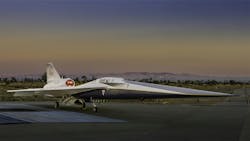NASA and Lockheed Martin unveil X-59 quiet supersonic aircraft
PALMDALE, Calif., - The National Aeronautics and Space Administration (NASA) and Lockheed Martin's division formally debuted the X-59 quiet supersonic aircraft at the company's Skunk Works facility in Palmdale, California on 12 January 2024. The X-59 is the centerpiece of NASA's Quesst mission, an initiative aimed at gathering essential data to prompt a reevaluation of regulations restricting commercial supersonic flight over land.
For half a century, both the U.S. and other nations have imposed prohibitions on such flights due to the disruptive impact of loud and jarring sonic booms on communities below. Anticipated to reach speeds 1.4 times the speed of sound, or 925 mph, the X-59 employs innovative design, shaping, and technologies to produce a more subdued sonic thump, addressing the noise concerns associated with supersonic travel.
The X-59 isn't merely a prototype but a distinctive experimental aircraft, conceived to impart valuable insights for the development of future generations of quiet supersonic aircraft. With the completion of its rollout, the Quesst team is now transitioning to the next phases, encompassing integrated systems testing, engine runs, and taxi testing in preparation for the X-59's inaugural flight.
Following NASA's comprehensive flight tests, the aircraft will be flown over various U.S. cities, carefully chosen to collect crucial data on the acoustic profile of the X-59 and its perceptibility to the public. NASA plans to share this data with regulatory bodies such as the Federal Aviation Administration (FAA) and international aviation authorities.
Measuring 99.7 feet in length and 29.5 feet in width, the X-59 boasts a unique configuration and technological advancements designed to facilitate quiet supersonic flight for future generations. Its distinctive features include a thin, tapered nose that accounts for nearly one-third of its length, strategically designed to disperse shockwaves and minimize the typical sonic boom associated with supersonic aircraft.
The cockpit, positioned almost midway along the length of the aircraft, adopts a novel approach due to the absence of a forward-facing window. In lieu of traditional visibility, the Quesst team introduces the eXternal Vision System, an innovative solution featuring high-resolution cameras feeding a 4K monitor within the cockpit.
Additionally, the aircraft's engine is intelligently mounted on top, and its smooth underside is crafted to prevent shockwaves from converging behind the X-59, effectively mitigating the creation of disruptive sonic booms. Through these pioneering design choices and technological advancements, the X-59 stands as a groundbreaking exploration into the realm of quiet supersonic flight, poised to shape the future of aviation.
“It’s thrilling to consider the level of ambition behind Quesst and its potential benefits,” said Bob Pearce, associate administrator for aeronautics research at NASA Headquarters in Washington. “NASA will share the data and technology we generate from this one-of-a-kind mission with regulators and with industry. By demonstrating the possibility of quiet commercial supersonic travel over land, we seek to open new commercial markets for U.S. companies and benefit travelers around the world.”
